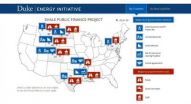(Press-News.org) Oil and gas development from shale fields has generally helped the public finances of local communities, providing new revenues and resources that usually -- but not always -- outweigh the increased demand for public services and other costs, according to a new analysis from two Duke University researchers.
Daniel Raimi and Richard Newell gathered data from communities surrounding 10 oil and gas "plays" from September 2013 through February 2014, traveling to Arkansas, Colorado, Louisiana, Montana, North Dakota, Pennsylvania, Texas and Wyoming to interview local officials and collect information firsthand.
The report, which appears online, describes major revenue sources for local governments, which can include property taxes, sales taxes and state-collected severance taxes or fees that are sent back to the local level. Some local governments also partner with oil and gas companies to help maintain roads, an approach that helped reduce expenses associated with heavy truck traffic in states including Arkansas, Colorado and Pennsylvania.
New costs for local governments associated with oil and gas development, include damage to roads from heavy truck traffic, water and sewer service expansion, government staffing and other needs brought on by rapid population growth.
The researchers found that the net impact of recent oil and gas development has generally been positive for local public finances. However, many local governments in western North Dakota and eastern Montana, near the Bakken shale formation, have thus far experienced net negative fiscal effects. Also, some municipalities in rural parts of Colorado and Wyoming struggled to manage rapid population growth as natural gas production accelerated in the mid-to-late 2000s.
"The fiscal effects for local governments tend to vary from state to state, but we found that for most of them new revenues were outweighing new demand for services," said Newell, director of the Duke University Energy Initiative and Gendell Professor of Energy and Environmental Economics at Duke's Nicholas School of the Environment.
The research is a snapshot of the fiscal impact to date in the eight states and does not examine the long-term economic impact to governments and the communities they serve, a question the authors say is important and needs additional study.
Newell and Raimi found net positive fiscal effects in regions where oil and gas booms were ongoing or had slowed in recent years, as well as in regions that experienced different scales of activity. This includes local governments in diverse regions where population density and government capacity vary substantially.
"One of the key questions is how these fiscal effects change over time," said Raimi, an associate in research with Duke's Energy Initiative. "In very rural areas, some local governments have faced challenges when development first surges. In many cases, those challenges faded over time. In most other areas, we found net positive or at least roughly neutral financial effects on local government."
"In some parts of North Dakota, populations have doubled, tripled or even quadrupled just in the past few years," Raimi said. "For local governments in these areas, it's hard to keep up with the demand for services, especially costly infrastructure projects such as sewer and water treatment plants."
INFORMATION:
The report is the first of a series of publications to be produced by the Shale Public Finance Project, an effort led by Newell with support from the Alfred P. Sloan Foundation. The project's website provides additional information, including interactive maps and a blog about sites visited during the research.
Shale development generally helps local government coffers
Revenue gains usually offset cost of new roads, utilities
2014-05-20
ELSE PRESS RELEASES FROM THIS DATE:
'Supermodel' mouse reveals mechanisms that regulate metabolism, researchers find
2014-05-20
DALLAS – May 20, 2014 – A lean "Supermodel" mouse type has revealed the potentially critical role played by a largely unknown gene that regulates metabolism, findings that could provide new insight into diseases ranging from diabetes to obesity, a new study by UT Southwestern Medical Center researchers suggests.
The Supermodel mouse's phenotype – the physical characteristics that result from its gene makeup – include being very small in size, with an unusual body form caused by abnormal distribution of fat, said Dr. Zhe Chen, Assistant Professor of Biophysics, and ...
Research explains action of drug that may slow aging and related disease
2014-05-20
CORVALLIS, Ore. – A proven approach to slow the aging process is dietary restriction, but new research in the Linus Pauling Institute at Oregon State University helps explain the action of a drug that appears to mimic that process – rapamycin.
Rapamycin, an antibiotic and immunosuppressant approved for use about 15 years ago, has drawn extensive interest for its apparent ability – at least in laboratory animal tests – to emulate the ability of dietary restriction in helping animals to live both longer and healthier.
However, this medication has some drawbacks, including ...
Shrub growth decreases as winter temperatures fluctuate up
2014-05-20
Many have assumed that warmer winters as a result of climate change would increase the growth of trees and shrubs because the growing season would be longer. But shrubs achieve less yearly growth when cold winter temperatures are interrupted by temperatures warm enough to trigger growth.
"When winter temperatures fluctuate between being cold and warm enough for growth, plants deplete their resources trying to photosynthesize and end the winter with fewer reserves than they initially had. In the summer they have to play catch up," said Melanie Harsch, a University of Washington ...
Game changer: Patients of doctors who played online game had better control of blood pressure
2014-05-20
Boston, MA – Primary care providers who engaged in an online game to solve clinical cases about hypertension management improved blood pressure control of their patients in a shorter amount of time compared to non-gamers, according to a new study by researchers at Brigham and Women's Hospital (BWH) and the Veterans Affairs Boston Healthcare System.
The study was published May 20, 2014 in Circulation: Cardiovascular Quality and Outcomes.
"This study is the first to show that an online educational game among medical professionals can improve the health measures of their ...
Screen of existing drugs finds compounds active against MERS coronavirus
2014-05-20
WHAT:
Clinicians treating patients suffering from Middle East respiratory syndrome (MERS) currently have no drugs specifically targeted to the MERS coronavirus (MERS-CoV), a virus first detected in humans in 2012 that has since caused 614 laboratory-confirmed infections, including 181 that were fatal, according to the World Health Organization. The case count escalated sharply in the spring of this year, and the first cases in the United States were announced in early May. To address the urgent need for therapies, researchers supported by the National Institutes of Health ...
Detroit Lions help rebuild city with innovative gridiron giving, U-M researchers say
2014-05-20
ANN ARBOR—The Detroit Lions' new model of philanthropy and community engagement may prove to be a touchdown for the city of Detroit.
A new case study of corporate social responsibility in sport by University of Michigan researchers uses the Lions as an exemplar of a professional sports team reinventing its charitable giving and community relations approach in hopes of making a bigger impact on the community.
In 2012, the Lions created the "Living in the City" campaign—a new model of corporate philanthropy that emphasizes deeper relationships with a small core group ...
UofL researcher and team explore broader definition of successful aging
2014-05-20
LOUISVILLE, Ky. – An aging population poses challenges for governments around the globe as nations grapple with how to satisfy the physical, social and economic needs of older adults. About 126 million adults 65 years and older live in China - the country with the largest population of senior citizens, while 40 million adults 65 years and older live in the United States.
In an article published today in Journal of Transcultural Nursing, University of Louisville School of Nursing assistant professor Valerie Lander McCarthy, PhD, RN; Ji Hong, MSN, a visiting scholar from ...
With climate changing, southern plants outperform northern
2014-05-20
Can plants and animals evolve to keep pace with climate change? A study published May 19 in the journal Proceedings of the National Academy of Sciences shows that for at least one widely-studied plant, the European climate is changing fast enough that strains from Southern Europe already grow better in the north than established local varieties.
Small and fast-growing, Arabidopsis thaliana is widely used as the "lab mouse" of plant biology. The plant grows in Europe from Spain to Scandinavia and because Arabidopsis is so well-studied, there is a reference collection of ...
The added value of local food hubs
2014-05-20
(Santa Barbara, Calif.) — As the largest purchaser of wholesale produce in Santa Barbara County, UC Santa Barbara's residential dining services provided the perfect avenue for a pilot project incorporating local pesticide-free or certified organic produce into an institutional setting.
The idea was conceived almost 10 years ago, when a group of students approached environmental studies professor David Cleveland about becoming a faculty adviser for student-led sustainable living classes. The group wanted to explore how to bring more local organic food in the dining halls. ...
Central Valley sees big drop in wintertime fog needed for fruit and nut crops
2014-05-20
BERKELEY — California's winter tule fog -- hated by drivers, but needed by fruit and nut trees -- has declined dramatically over the past three decades, raising a red flag for the state's multibillion dollar agricultural industry, according to researchers at the University of California, Berkeley.
Crops such as almonds, pistachios, cherries, apricots and peaches go through a necessary winter dormant period brought on and maintained by colder temperatures. Tule fog, a thick ground fog that descends upon the state's Central Valley between late fall and early spring, helps ...
LAST 30 PRESS RELEASES:
Structure of dopamine-releasing neurons relates to the type of circuits they form for smell-processing
Reducing social isolation protects the brain in later life
Keeping the heart healthy increases longevity even after cancer
Young adults commonly mix cannabis with nicotine and tobacco
Comprehensive review illuminates tau protein's dual nature in brain health, disease, and emerging psychiatric connections
Book prepares K-12 leaders for the next public health crisis
Storms in the Southern Ocean mitigates global warming
Seals on the move: Research reveals key data for offshore development and international ecology
Sports injuries sustained during your period might be more severe
World's first successful 2 Tbit/s free-space optical communication using small optical terminals mountable on satellites and HAPS
Can intimate relationships affect your heart? New study says ‘yes’
Scalable and healable gradient textiles for multi‑scenario radiative cooling via bicomponent blow spinning
Research shows informed traders never let a good climate crisis go to waste
Intelligent XGBoost framework enhances asphalt pavement skid resistance assessment
Dual-function biomaterials for postoperative osteosarcoma: Tumor suppression and bone regeneration
New framework reveals where transport emissions concentrate in Singapore
NTP-enhanced lattice oxygen activation in Ce-Co catalysts for low-temperature soot combustion
Synergistic interface engineering in Cu-Zn-Ce catalysts for efficient CO2 hydrogenation to methanol
COVID-19 leaves a lasting mark on the human brain
Scientists use ultrasound to soften and treat cancer tumors without damaging healthy tissue
Community swimming program for Black youth boosts skills, sense of belonging, study finds
Specific depressive symptoms in midlife linked to increased dementia risk
An ‘illuminating’ design sheds light on cholesterol
Who is more likely to get long COVID?
Study showcases resilience and rapid growth of “living rocks”
Naval Research Lab diver earns Office of Naval Research 2025 Sailor of the Year
New Mayo-led study establishes practical definition for rapidly progressive dementia
Fossil fuel industry’s “climate false solutions” reinforce its power and aggravate environmental injustice
Researchers reveal bias in a widely used measure of algorithm performance
Alcohol causes cancer. A study from IOCB Prague confirms damage to DNA and shows how cells defend against it
[Press-News.org] Shale development generally helps local government coffersRevenue gains usually offset cost of new roads, utilities






